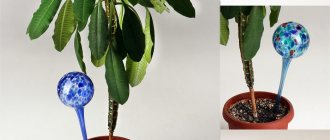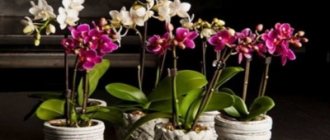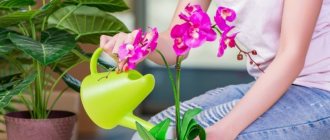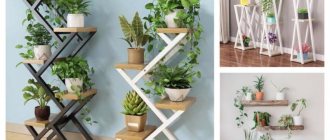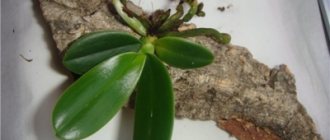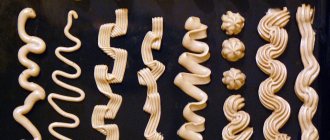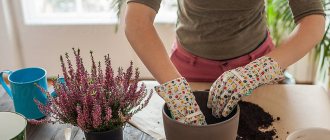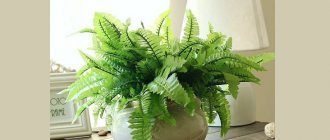The beginning of summer is the time when the main dacha chores are over, and gardeners finally get around to flowers in their flowerbeds and flower pots. How to properly plant flowers in plastic containers, ceramic pots and wooden boxes? How to make an outdoor planter with your own hands? And which flowers will grow well in flowerpots and containers, and which ones will not like it?
A container garden is a special element of the landscape that allows you to implement unusual ideas in the garden. They complement large forms, tying the floral decoration of the garden into a single composition.
And container gardens are mobile flower beds. With your help, they can “travel” around the garden, changing its appearance each time. If you want, for example, to decorate a shady seating area for the arrival of guests, then simply place a group of containers with bright flowers on it.
You can grow the most demanding flowers in a container, as it is easier to create specific conditions for such plants. And in case of unfavorable weather conditions, containers can be easily brought into the house.
You can also display containers in flower beds: this will come in handy when some flowers have already faded and you urgently need to decorate the empty spaces. This technique is especially good after the spring bulbs have faded - after all, in the second half of summer they don’t even have foliage left.
Containers can be of any size, but you should still try to ensure that even the largest container can be moved if necessary.
Containers for flowers: flower pots or flower pots?
Flower containers can have holes and be flower pots - or not have them and be flower pots. Both pots and flowerpots can be miniature, literally holding one flower, or they can be giants, with a diameter of more than a meter, capable of containing a fairly large tree.
Planting flowers in pots requires special conditions - because there is no water flow, and it is more difficult for the roots to breathe. As a rule, flower pots of appropriate size and shape are inserted into flower pots. However, it often happens that a pot has an original design, a non-standard shape, and it is impossible to choose a pot for it. It is also impossible to punch holes, otherwise the flowerpot will crack.
Well, you can plant flowers directly in pots, but then you need to provide especially good drainage: at least one third of the pots should be occupied by expanded clay and sand, and the soil should be light, not clayey. You need to water the plants in the pots carefully, little by little, using a small teapot or watering can with a thin spout.
Perennials
Perennial flowers for pots have to be brought indoors for the winter. But with the onset of spring, you can again take them outside, onto the terrace or balcony and enjoy the abundant flowering.
Viola
Another name for the plant is pansy. There are special hanging varieties that grow well in a small pot. Pansies are unpretentious and are distinguished by the unusual color of their buds. From a distance they resemble a cat's eye. One inflorescence can combine yellow, black, and purple shades.
Convolvulus
The second name of the culture is morning glory. It is one of the most common for growing outdoors or indoors. The shoots of the plant resemble a grape vine. The foliage is narrow, elongated. Funnel-shaped flowers live for 1 day, then fade, but new buds appear in their place, the color of which varies from white to purple.
Dichondra
A perennial for flowerpots, which is classified as a member of the bindweed family. The shoots grow up to 1.5 m. The decorative nature of the crop lies in the surprisingly beautiful leaves, round, bright green, up to 2.5 cm in diameter. Inconspicuous yellow buds up to 2 mm in size appear on the plant.
Lobelia
A perennial crop that grows wild in North America. Flower growers often use it as an annual plant for pots. But if you bring lobelia into the house with the onset of cold weather, next year it will delight you with blue, purple or dark red inflorescences.
Related article:
Secrets of hydrangea
The leaves of the crop are elongated and thin. The shoots grow up to 50 cm. Located in a container, lobelia resembles a waterfall due to the abundance of bright buds, behind which foliage and stems are almost invisible.
Nasturtium
A spectacular herbaceous perennial that delights with flowering until frost. The leaves are round in shape, variegated or with a brownish tint. The buds are double or semi-double, of various shades. In their place, large seeds up to 7 mm in diameter are formed. The culture is suitable for decorating balconies and gazebos.
Chlorophytum
An unpretentious bush that creates a decorative effect thanks to the special color of the foliage. It is distinguished by a light green tint with white veins. The buds are small, with a snow-white tint. The bushes tolerate drought well and grow both in the shade and in the sun in any soil. If the plant has withered, it quickly revives after watering.
Flower container material
Depending on the material, containers can be ceramic, plastic, wood and metal. Each material has its own characteristics, and planting in them should be done differently.
Ceramic pots are best suited for plants - moisture passes through them well, since ceramics are hygroscopic, maintain an optimal temperature regime, and plant roots “breathe” over the entire surface. But ceramic containers are fragile and heavy, starting from medium sizes.
Plastic containers retain moisture for a long time - you can go longer without watering. But they “steam” the roots, and they can only breathe from the surface. At the same time, plastic is light and durable.
Wooden boxes are almost as good as ceramic ones, but they are very short-lived, and if they get wet, they maintain high humidity in the container.
Metal containers are the most difficult. The roots do not breathe in them, and the containers themselves either become very hot or very cold, depending on the weather. When they heat up, the plants in them are too hot and they quickly evaporate moisture. When they are cooled, the roots are cold as a result, and the container is constantly damp. Metal containers are very durable and medium-heavy.
Care
During the summer months and only after the growing stage, standard liquid fertilizers should be added to the water every third watering in accordance with the instructions on their packaging.
Plants should be in a lighted place. Note: Some plants prefer partial shade rather than direct sunlight.
In very dark rooms it is recommended to use phytolamps.
At temperatures below 0°C, plants should be protected from frost.
How to plant flowers in outdoor pots correctly
The most important thing is to ensure the right ratio of soil and drainage.
For ceramic containers, it is enough to pour a little expanded clay on the bottom so that the bottom is closed. Then you can add soil and plant the plant. Planting in a wooden container is similar, but slightly more expanded clay is required. For a plastic container, on a layer of expanded clay, you need to pour a layer of coarse river sand 1.0–1.5 cm thick. You should try to choose a lighter soil, preferably mixing it with perlite.
When planted in a metal container, expanded clay occupies one third of the height of the container, followed by a layer of sand and light soil. However, in hot weather it is still better to move such containers into the shade, and in rainy and cold weather put them under a canopy or in a gazebo, and the place should be protected from the wind.
Accordingly, if your containers are flowerpots, then all specified drainage rates should be increased.
Master class on planting plants in hanging pots
1. Line the inside of the liner with plastic wrap so that its top edge is below the edge of the basket. Place a saucer (tray) at the bottom to retain and preserve moisture.
Fill the basket halfway with damp soil mixture and compact the soil.
Make 3–5 holes in the wall of the basket above the soil surface.
Carefully insert the seedlings of hanging plants into the holes so that the roots lie on the surface of the soil and the plant itself is outside. To avoid damaging the roots and shoots, you can wrap the seedlings in film.
Water the soil. If necessary, add soil to the pots.
Fill the basket with soil 1–2 cm below the top edge of the liner, lightly compact it again and begin planting the rest of the plants: plant upright plants in the center, and hanging ones closer to the edge.
After planting, the plants need to be watered well, and the basket should be left on the veranda, loggia or in the greenhouse for several days, and only when the plants have taken root can it be taken out into the garden.
Caring for flowers in containers
Features of caring for container flowers follow from the conditions that containers provide. Either way, containers have little soil, little nutrients, and often little moisture. Therefore, plants in containers need to be watered and fed much more often than in open ground. You can use the same fertilizers as for the main flower beds in the garden, or you can buy special, more concentrated ones, usually sold in bottles.
Be sure to cut off faded inflorescences from time to time; this should be done much more often than with flowers in the ground.
Soil for planting plants in hanging pots
The soil mixture for flower baskets should be light, nutritious, well-permeable and at the same time retain moisture well. It is prepared from high-moor peat, sand (agroperlite) and humus (or vermicompost) in a ratio of 3(4):1:1. If you visit the garden occasionally, add hydrogel (to reduce the number of waterings and so that the baskets can wait for the owners to arrive for the next day off) and slow-acting fertilizers (to avoid weekly fertilizing). You can buy a ready-made peat mixture for annuals and add fertilizer to it. You can read more about the use of hydrogel here >>>.
What flowers to plant in containers
Not all flowers are comfortable in small containers. If you have large containers with a diameter of more than 30 cm, then you can plant any garden flowers in them, and if your containers are more than 45–50 cm in diameter, then even perennials.
If you want to plant a perennial and the container is smaller than the required size, you will need to bury it in the ground to surface level during the winter so that the flowers can successfully overwinter.
If you have small containers, then it makes sense to plant flowers that are undemanding in terms of soil volume. These are petunia, lobelia, violas, ageratum, marigolds, low-growing varieties of zinnias, asters, daisies, verbena, salvia, calendula, begonia, “Jolly Fellows” dahlias, all spring bulbs, gladioli.
But nasturtium is very capricious in this regard. Decorative sunflower loves large containers; in small containers it can only grow in a very “reduced” version. Climbing flowers also do not tolerate a small volume of soil, of which the only exception is sweet peas, and even then to a certain extent.
Selecting plants for pots
For flower hanging baskets, plants are selected that are able to grow well in a small volume of soil and successfully coexist with their neighbors. For hanging crops, it is also important that their shoots are not exposed. Additional “advantages” include abundant tillering.
Along the edges and in the walls you can plant:
Ampelous petunias*, lobelias*, fuchsias*, bidens, prostrate sanvitalia, hybrid verbena, scaevola, diascia, angelonias, cordate bacopa (suteru), ivy-leaved pelargonium*, short-climbing varieties of sweet peas, creeping gypsophila, calibrachoa*, torenia, petiolate cinnamon, plectranthus*, chlorophytum*, silver dichondra, ivy*, tradescantia*, ivy budra*, loosestrife*, yellow zelenchuk*.
*species that tolerate shade are noted
In the center of the flowerpot you can plant:
Dwarf varieties of beautifully flowering annuals: marigolds, zonal pelargonium*, begonias (always flowering and tuberous)*, ageratum, snapdragon, balsam*, hybrid verbena, dimorphotheca notemata, lobelia erinus*, marine lobularia, nemesia groinoid, brachycoma iberisolifolia, osteospermum Eklona, compact multifloral petunia*; coleus, cineraria maritima.
Flowers in the country: how to design a container garden
Containers can, of course, be placed arbitrarily within the kindergarten. It will still be beautiful. But you can add some design elements for a container garden:
- make a small (5–10 cm) podium;
- build a wooden garden shelf with steps;
- surround the container garden with a ready-made decorative fence;
- place containers in the garden according to some geometric pattern;
- put beautiful stones (not too large) between the containers, arrange garden figurines;
- place small solar-powered lights in some containers;
- sprinkle the free soil in containers with decorative pebbles or shells;
- wrap large containers with embossed synthetic fabric, burlap or coconut copra;
- placing plants in approximately identical containers in shape, color, material - this is the most stylish garden option. If all the plants are in approximately the same containers, a unified impression will be created, and the flowers themselves will attract attention;
- set up a container garden on the steps of an old staircase. To do this, both the ladder itself and the containers need to be painted in a harmonious color scheme.
If all the containers in your garden are different, you need to come up with some kind of story for combining them. You can, for example, make such a garden a monogarden - the containers are all different, but the flowers are of the same type, for example, only petunias. Or supplement the garden with containers with plants that have discreet flowers but decorative foliage, such as hostas and kochia. Another option is to plant flowers in each container of the same color as the container itself. For example, in your garden there is a container with a picture of red tulips on it. This means planting a plant with red flowers in it (not necessarily tulips, although this is impressive). And plant ageratum in a blue container.
Planters with self-watering Lechuza in the store catalog:
| Classico and Classico LS | Quadro and Quadro LS |
| Cube, Cube Cottage and Cube Color | Cubico, Cubico Alto, Cubico Cottage and Cubico Color |
Options for ready-made flower arrangements
The ideal solution is to purchase a large flowerpot and create a whole flower arrangement in it. True, this business has its pitfalls that you should be aware of.
- Option one. Asters can be planted in the central part of the composition. It is most beneficial to surround asters with pansies or similar low-growing ornamental plants. The outer circle of the pots should be occupied by cascading representatives of the flora. They can be, for example, lobelias or scaevolas.
- Option two. A fundamentally different version of a flower garden in a flowerpot is composed as follows: the center of the composition is occupied by low flowering plants with erect stems, and climbing representatives of the flora are located around them.
- Option three. This option is suitable for flowerpots that are located along a wall or other vertical surface. In this case, the outer field in the container should be given to climbing or low-growing representatives of the flora. And the central part of the composition and the location that is closer to the wall - taller ornamental plants.
Please note that when combining flowers in one pot, you need to select them according to the care principle: since they will live in the same soil, it is important that their needs coincide.
It’s quite easy to get confused in the variety of plants for pots. But to understand who will get along with whom, and who needs to be kept away from potential “partners”, who of the flowers knows how to be strong friends, and who is mostly belligerent, is extremely difficult. So here's a little cheat sheet for you.
- If you want to get a delicate pinkish-pastel tandem, plant alyssum and begonia in one pot.
- The best partner for violets is carnation.
- A wonderful combination is the trio of verbena, fuchsia and petunia, which creates very bright and catchy floral arrangements.
- Ivy goes well with lobelia. For example, where you need to plant several climbing, low-growing representatives of the flora at once.
And finally, about pelargonium: this plant can be combined in pots with any flowers. Therefore, you can consider pelargonium absolutely universal and use it for any flower experiments.
Flowers that love light
Planting flowers in the same pot that cannot live without an abundance of sunlight, along with flowers that die in the sun and that need partial shade conditions for comfort, is a real crime. To prevent you from doing it out of ignorance, we have prepared for you a list of ornamental plants that love light and those that prefer darkness:
- petunia, in fact, only needs sun and watering: under such conditions it will bloom for months on end;
- Although alyssum is not very noticeable in appearance, if there is enough sunlight it turns into a real highlight of the container composition;
- geranium does not like temperature changes, but lives calmly without watering.
Flowers that prefer shade
Morning glory is one of those plants that blooms most beautifully in partial shade. But besides morning glory there are others. For example:
- viola;
- celosia;
- lobelia;
- marigold;
- perennial verbena.
Balsam
Small balsam bushes can be seen on balconies and terraces throughout Western Europe, but in our country this plant with beautiful dark green leaves and large delicate flowers has found many fans. Varieties for keeping in outdoor pots have a height of 25-50 cm, color from peach-pink to bright purple and a long flowering period - from April to October.
To people of the older generation, balsam is known as “Wet Vanka” because of its ability to release excess moisture from the foliage in the form of dew drops.
Calibrachoa
The plant is surprisingly similar to petunia and for a long time was considered its subspecies, but biologists have found a fundamental difference both in the genomes of these crops and in the conditions of their maintenance. Calibrachoa also loves bright sun, but needs strictly dosed watering, since its root system quickly rots due to waterlogging.
In order for the flower to live up to its name (“Million Bells”), it must be trimmed regularly during the growing season.
Which indoor plants are unpretentious?
Many plants can decorate our lives without requiring much time-consuming hassle in return. We offer you a list of the most unpretentious indoor plants. ...
- ALOE...
- Kalanchoe...
- Crassula or Crassula...
- Haworthia or Gavortia...
- Euphorbia, Euphorbia...
- Ivy...
- Sansevieria, pike tail...
- Tradescantia, Chlorophytum and Ficus
13 Apr
2022 Interesting materials:
What part of the continent is Egypt located? Which part of the mainland does the Congo flow through? What part of the continent is the USA located? What part of the continent does the Amazon River flow to? Which part of the continent does the Volga River flow in which direction? Which part of speech does the other belong to? Which part of speech refers to whom? What part of speech is above? What part of Russia is Novosibirsk located? What part of the country is Russia located?
Features of cultivation
But flowers that grow in pots require special attention and care. Moreover, not every plant can be planted in such a container. Some plants will be very uncomfortable if you try to grow them in a pot.
In addition, when planting flowers, you must pay attention to where they will grow. Indoor flowers in pots outside can feel bad even in the warm season. Due to excess light and heat, they may not survive. Therefore, for outdoor pots, you should choose garden flowers that will not be too whimsical and will withstand weather surprises well.
If everything is done correctly, you can grow very beautiful flower arrangements in flowerpots. Such decorations will not leave anyone indifferent and will be the real pride of the hostess.
Thuja
The spherical dwarf thuja does not bloom at all, but when displayed on a loggia or porch in large pots and tubs it looks wonderful. She needs a spacious container with good drainage and slightly acidic sandy loam soil, which can be purchased ready-made or assembled independently. Thuja will survive a not too harsh winter outside, but it is better to take it out into the air at temperatures above +4 degrees.
The main advantage of this coniferous crop is that it is evergreen, that is, it does not take weekends or vacations in decorating your home.
When choosing plants for outdoor pots, be guided not only by aesthetic qualities, but also by the characteristics of their contents, then you will not have to regret the effort and money spent standing over yet another withered “favorite.”
